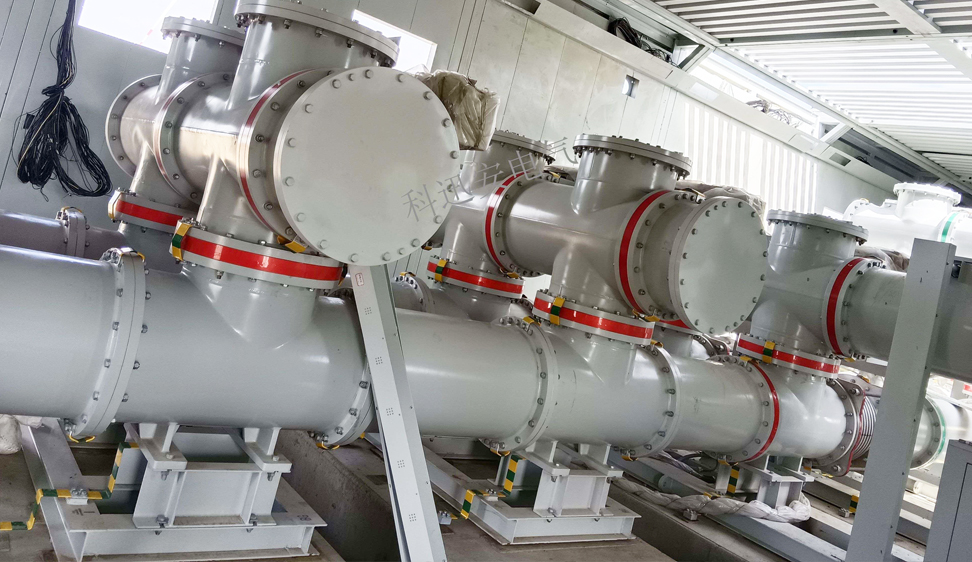Definition, Components, and Applications for Gas Insulated Switchgear
2024-04-09

Gas-insulated switchgear (GIS) is an electrical equipment that employs a gas like sulfur hexafluoride (SF6) to insulate and safeguard different parts of a power system. It comprises compartments enclosed in metal that contain circuit breakers, disconnectors, bus bars, transformers, earth switches, surge arresters, and other components. GIS is predominantly utilized for medium and high voltage purposes, especially in situations where space is constrained and dependability is crucial.
This article will define GIS, including its benefits, drawbacks, and uses. Additionally, we will compare GIS to AIS, the traditional form of switchgear utilizing air for insulation.
What is Gas Insulated Switchgear?
A gas-insulated switchgear (GIS) is characterized as a metal-encased switchgear that employs a gas, like SF6, as the primary insulation between active parts and the grounded metal housing. The gas offers superior dielectric strength, thermal stability, and impressive arc extinguishing capabilities.
The main components of a GIS are:
Circuit breakers: These devices are designed to break the flow of electric current in a circuit when a problem arises. They utilize either a vacuum or SF6 as the medium for interruption, chosen based on the voltage and purpose of the circuit.
Disconnectors: These devices are capable of isolating a specific part of a circuit from the rest of the system, allowing for maintenance or testing to be performed without disrupting the entire system. They utilize SF6 as the insulation medium and can be controlled either manually or remotely.
Bus bars: These conductors link various sections of the electrical system, like generators, transformers, and feeders. They utilize SF6 for insulation and are set up in a three-phase configuration.
Transformers: These devices can modify the voltage level of an electrical circuit, utilizing SF6 as the insulating medium. They can be classified as either power transformers or instrument transformers, which include current transformers or voltage transformers.
Earth switches: These devices are used for safety and grounding by connecting part of the circuit to the earth. They utilize SF6 as the insulation medium and can be controlled either manually or from a distance.
Surge arresters: These devices are designed to safeguard circuits from voltage surges caused by lightning or switching events. They utilize SF6 as the insulating material and can be classified into two types: metal oxide varistors (MOVs) or spark gaps.
The components are housed within a metallic casing that is filled with SF6 gas at a specific pressure. The casing is categorized into several sealed sections, separated by gas-tight partitions. The sections are linked by gas pipes and valves that facilitate gas flow and pressure regulation.
The enclosure comes with sensors, monitors, indicators, alarms, and control devices to guarantee the GIS's safe and efficient functioning. Depending on the environmental conditions and design needs, the enclosure can be situated indoors or outdoors.
How Does Gas-Insulated Switchgear Work?
The main principle of GIS operation is to use SF6 gas as an insulator and an arc extinguisher. SF6 gas has several advantages over the air as an insulation medium.
◆ It has a higher dielectric strength than air, which means it can withstand higher voltages without breakdown.
◆ It has a lower molecular weight than air, which means it has a higher thermal conductivity and can dissipate heat more efficiently.
◆ It has a higher electronegativity than air, which means it can more effectively capture free electrons and reduce ionization in the arc.
These properties make SF6 gas ideal for GIS applications, where space is limited and reliability is essential.
The operation of GIS can be explained by using an example of a three-phase circuit breaker. Under normal conditions, the circuit breaker contacts are closed, and current flows through them. When a fault occurs in the circuit, such as a short circuit or an overload, the contacts separate, and an arc occurs between them.
The arc is composed of ionized gas that conducts electricity. The arc generates heat and pressure that can damage the contacts and other components. To prevent this, the arc must be extinguished as quickly as possible.
The arc extinction process in GIS involves two mechanisms: thermal interruption and dielectric interruption.
Thermal interruption: This process depends on lowering the temperature of the electrical arc by transferring heat to the nearby gas. As the arc becomes cooler, its resistance goes up, causing the current to decrease until it reaches zero at a natural current zero crossing point. When this happens, the arc is put out.
Dielectric interruption:This system depends on boosting the gas's ability to resist electrical breakdown by eliminating the ionized particles in the path of the electrical arc. When the arc is stopped, SF6 gas enters the space and captures the unbound electrons, creating molecules without a charge that cannot carry an electric current. The gas's ability to resist breakdown quickly returns to normal, stopping the arc from reigniting.
After the arc is extinguished, the contacts close again, and the circuit is restored. A gas management system monitors and controls the SF6 gas pressure and also ensures gas quality and leakage detection.
Gas-Insulated Switchgear Applications.
GIS is widely used in various applications due to its compactness, reliability, and low maintenance requirements. Some of the common applications of GIS are:
Urban or industrial areas: GIS is ideal for urban or industrial areas where space is scarce and pollution levels are high. GIS can be installed indoors or outdoors, on roofs, underground, or offshore platforms, without affecting the environment or aesthetics.
Power generation and transmission: GIS is used to connect power plants to the grid, as well as to transmit and distribute power over long distances and across different voltage levels. GIS can handle high currents and voltages, as well as provide protection and control functions for power systems.
Renewable energy integration: GIS is used to integrate renewable energy sources, such as wind farms or solar plants, into the grid. GIS can provide flexible and reliable connections, as well as voltage and frequency regulation for intermittent power generation.
Railways and metros: GIS is used to supply power to railways and metros, as well as to control and protect their electrical systems. GIS can reduce losses and improve efficiency, as well as provide safety and reliability for passengers and operators.
Data centers and factories:GIS is used to supply power to data centers and factories, where high-quality and uninterrupted power is essential for their operation. GIS can provide high availability, redundancy, and fault tolerance, as well as reduce electromagnetic interference and harmonics.
Comparing Gas Insulated Switchgear with Air Insulated Switchgear.
Gas-insulated switchgear (GIS) has several advantages over air-insulated switchgear (AIS), which is the conventional type of switchgear that uses air as the insulation medium. Some of the advantages of GIS are:
Space saving: Geospatial Information Systems (GIS) can significantly minimize the spatial requirements of a substation, shrinking its footprint by up to 90% when contrasted with Air-Insulated Switchgear (AIS). This remarkable reduction is achievable since GIS can be housed within a single or multi-story edifice or buried underground, thereby eliminating the need for an expansive open area typically required by AIS for installation and upkeep.
Safety: Geographic Information System (GIS) technology can greatly improve the security of personnel and equipment by eradicating the risks associated with live parts and arc flash hazards. Additionally, GIS minimizes the likelihood of fire, explosion, or environmental pollution, as it contains SF6 gas in a secure, leak-proof enclosure.
Reliability: A Geographic Information System (GIS) can enhance the dependability of a power supply by minimizing the number of movable components and connections that can deteriorate or malfunction. In addition, GIS has a longer lifespan compared to an Automatic Identification System (AIS) since it is less susceptible to environmental influences like humidity, dust, corrosion, or pollution.
Maintenance: Using GIS can lower maintenance expenses and minimize downtime because it needs less regular maintenance and checks compared to AIS. GIS is equipped with self-diagnostic capabilities that can identify issues and notify operators before they escalate.
Nevertheless, GIS does have drawbacks in comparison to AIS, particularly in terms of cost. GIS is pricier than AIS in terms of upfront costs and ongoing operation expenses. This is due to the need for more advanced technology and materials, along with stricter quality standards and testing processes.
Complexity: GIS exhibits a higher level of complexity in its design and implementation compared to AIS due to the need for increased coordination and integration among various components and systems, including gas management, protection, control, communication, and others.
Availability: GIS may not always be as accessible as AIS, particularly in situations where a fault occurs within a compartment, impacting several components. This is due to the fact that GIS typically demands a more extensive amount of time and resources to identify and rectify the fault compared to AIS. As a result, the decision on whether to opt for GIS or AIS is contingent upon a range of factors, including site conditions, technical requirements, economic considerations, and individual preferences.
Types and Models of Gas-Insulated Switchgear.
There are different types and models of gas-insulated switchgear available from various manufacturers. Some of the common types are:
Isolated phase GIS: In this type, each phase of the circuit is assembled separately in its compartment. This type requires more space than other types of GIS, but it prevents phase-to-phase faults.
Integrated three-phase GIS: In this type, all three phases of the circuit are assembled in a single compartment. This type reduces the space requirement by one-third compared to isolated phase GIS.
Hybrid GIS: In this type, a combination of isolated phase and three-phase elements is used. This type provides a balance between space saving and fault prevention.
Compact GIS: In this type, more than one functional element is encapsulated in a single compartment. For example, a circuit breaker, a disconnector, and a current transformer can be combined in one module. This type reduces the space requirement further compared to other types of GIS.
Highly integrated system (HIS): In this type, all the substation equipment is encapsulated together in a single enclosure. This type provides a complete solution for an outdoor substation in a single unit, eliminating the need for external connections and reducing installation time.
Conclusion.
Gas-insulated switchgear is a type of electrical equipment that uses a gas, such as SF6, as the primary insulation and arc extinguishing medium. It consists of metal-enclosed compartments that house various power system components, such as circuit breakers, disconnectors, bus bars, transformers, earth switches, surge arresters, etc.
GIS has several advantages over air-insulated switchgear, such as space-saving, safety, reliability, and low maintenance. However, GIS also has some disadvantages, such as high cost, complexity, and lower availability in some cases.
GIS is widely used in various applications, such as urban or industrial areas, power generation and transmission, renewable energy integration, railways and metros, data centers, and factories. Depending on the voltage level and design requirements, different types and models of GIS are available from different manufacturers.
GIS is a modern and advanced technology that can provide efficient and reliable solutions for power systems. However, it is important to understand its characteristics, advantages and disadvantages, and applications before choosing the type of switchgear for a specific project.





